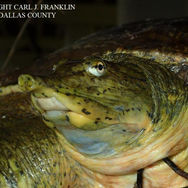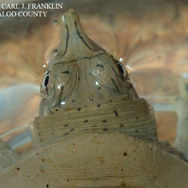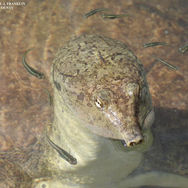
SPINY SOFT SHELL TURTLE (Apalone spinifera), (LESUEUR, 1827)
IDENTIFICATION: Females grow to 1.6 times the size of males with a carapace length up to 21 inches ( 54 cm). Adult males have a carapace length of 5-9 inches (12.7-23 cm). The carapace is round and covered in a leathery skin with a series of blunt or conical tubercles at the anterior edge. A series of tubercles are sometimes present on the posterior half of the carapace which in younger adult specimens has a rough texture due to numerous tiny spines. Males retain a more disk shaped carapace while the carapace of mature females is more oval. The outer edges of the carapace are flexible and soft, especially the posterior portion above the tail. The carapace is olive to orange-brown with a series of spots. As females mature the spots fade and the carapace is either plain or blotched. A thin yellow band borders the outermost edge of the shell. The border is rimmed along the inner edge by a thin dark line. The plastron is white to gray or bluish gray. The ventral coloration of the limbs matches that of the plastron. The color of the top of the head, neck, limbs and tail closely matches the base coloration of the carapace. Adult female pallid spiny soft shells have a bluish chin and throat and mature female Texas spiny soft shell turtles will bear orange colored lips. The exact role of these colors is currently unknown. A creamy yellow line thinly bordered above and below by a darker base coloration is present behind the yellow-orange eye (post orbital stripe) extending along the back of the head to the long neck. In younger specimens this line extends in front of each eye and comes into contact near the base of the nostrils. The head is elongated with yellow to olive colored lips covering a sharp cusp and tubular nostrils that internally are partially divided. The feet are fully webbed and the webbing on the forefeet reaches just beyond the elbow while webbing on the rear feet reaches the shank. The webbing between the toes is spotted with a pattern that matches the skin on the limbs. The limbs are flecked in dark spots.
BEHAVIOR AND ECOLOGY: Soft shell turtles are powerful swimmers and almost entirely aquatic, fond of basking and usually staying close to their aquatic habitat. However, nesting females sometimes wander considerable distances from water in search of ideal nesting locations. Within their geographic distribution spiny soft shell turtles can be found in streams, rivers, oxbows, lakes, lagoons, water filled ditches and coastal areas. Soft shell turtles are carnivorous and will hunt down or use ambush tactics to secure prey which includes but is not limited to: insects, crayfish, tadpoles, frogs, fishes and other small vertebrates. Aquatic vegetation has been found in the stomachs of museum specimens. However, the vegetation contained snails and were likely ingested secondarily to the turtle's pursuit of the snails. When not basking out of the water or swimming about, soft shelled turtles can be found below the surface on the bottom concealed beneath a layer of sand or other substratum. Often with only the eyes or part of the head exposed.
Females are fecund producing 1-2 clutches per year containing as many as 3-39 spherical and brittle-shelled eggs per clutch. Clutch size is dependent upon the size of the female. Soft shell turtles are capable of defending themselves by clawing, and scratching while trying to make an escape. They can even make short yet remarkably quick bursts of speed on land. If carelessly handled, soft-shelled turtles can also deliver a painful bite with their sharp cusp.

Guadalupe spiny soft-shell turtle (Apalone spinifera guadalupensis), (WEBB, 1962)

Guadalupe soft-shell turtles are endemic to Texas and occur in the Colorado, Guadalupe, Lavaca, Nueces and San Antonio River systems. Among young specimens and males, white-yellow tubercles ringed with black are present on the carapace. These markings are present among males but absent in adult females. Females reach a straight carapace length of 35.2 cm (13.8") and males 17.3 cm (6.8"). Measurements taken from Menard County specimens from the San Saba River.
Pallid spiny soft-shell turtle (Apalone spinifera pallida), (WEBB, 1962)

Pallid spiny soft-shell turtles occur in the Brazos, Neeches, Red, Sabine, San Jacinto and Trinity River systems. White tubercles without rings are present on the posterior half of the carapace among young specimens and males. Females reach a straight carapace length of 47 cm (18.5") and males 23.7 cm (9.3"). Male size record from specimen captured in Buffalo Bayou, Houston, Texas.
Texas spiny soft-shell turtle (Apalone spinifera emoryi), (AGASSIZ, 1857)

Texas spiny soft-shell turtles occur in the Pecos and Rio Grande river systems. The light border on the carapace is 4-5 times wider at the rear than the sides. Females reach a straight carapace length of 45 cm (17.7") and males 22.7 cm (8.9"). Female size taken from UTA R 55371 (Val Verde County, Texas) and male size from data published by Legler and Vogt, 2013.
LITERATURE CITED
Crump, P.S & J. McLaughlin. 2020. Geographic Distribution: Apalone spinifera (Spiny soft-shell turtle). Jack County. Herpetological Review . 51 (3). pp. 535
Legler, J.M.& Vogt, R.C. 2013. The Turtles of Mexico: Land and Freshwater Forms. University of California Press, 416 pp.
Lindeman, P.V. 2020. Geographic Distribution: Apalone spinifera (Spiny soft-shell turtle). Morris County. Herpetological Review . 51 (3). pp. 535







































